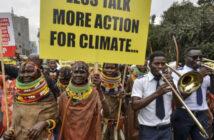A major U.N. report of global education progress on meeting key targets by 2015 was published on Thursday. Below is a brief summary of some of the countries that are making positive strides and those lagging behind.
Top Performers
Afghanistan: Years of civil war and the Taliban regime meant Afghan education was considered the world’s worst in 2000. Schools and teachers were attacked, no girls were in secondary school and only 4 percent attended primary. By 2012, it had made the fastest progress of any country towards gender parity with 87 percent of girls in primary. It has also had one of the biggest rises in secondary enrolment. Government initiatives to increase the number of female teachers and build schools in remote areas have contributed to progress.
India: The largest education system in the world has slashed its out of school population. In 1999 India had almost 17 million children out of school and around 8 girls for every 10 boys in school. The number of out-of-school children has fallen to just over a million, universal primary education has been achieved and this year India is predicted to be the only country in South and West Asia to have an equal number of girls and boys in both primary and secondary education.
Nepal: Nepal has achieved universal pre-primary and primary education, despite a relatively recent conflict in which schools were targets. The number of pupils per trained teacher is around 28, down from 260 in 1999. Efforts to encourage girls’ education have been so successful that there are more girls than boys in primary school. The country has increased its spending on education more than its economic growth – a sign of the priority it is accorded.
Sierra Leone: The country’s long civil war saw children recruited as soldiers or slaves. Most children were out of school and many schools were destroyed. Since the end of the conflict in 2002, Sierra Leone has halved the number of children who have never been to school, one of only 10 countries to do so. The west African country has tackled child labour, which keeps children out of school, and uncovered 1,000 “ghost-teachers” – where teachers die or leave but the school still claims money for them – recovering $195,000.
Tanzania: Tanzania has achieved universal education. It has a gender sensitive curriculum and has introduced water facilities in communities to ensure girls can go to school rather than having to spend hours collecting water. It has brought in an education plan specifically for its nomad population, textbooks in braille, schools for the disabled and has abolished school fees. Other initiatives have helped reduce early pregnancy rates, a key factor in curtailing girls’ education.
Worst Performers
Chad: This central African country is bottom of the index. Less than 70 percent of children are enrolled in primary school – a small improvement from just half in 1999, but fewer are staying on to the end of school now than were then. There are half as many girls as boys in secondary school. On average there are more than 100 pupils per teacher and less than two thirds of primary teachers have any training.
Niger: Inequality has increased in Niger – second bottom behind Chad – leaving the poorest far less likely to get a free education than they were at the start of the millennium. The poorest are now 50 times less likely to attend early childhood programmes than the richest. The proportion of poor children completing primary school halved from 10 percent to 5 percent between 2000 and 2010. Primary school enrolment has increased but spending per student has halved.
Nigeria: Corruption, conflict and a lack of investment has left Nigeria with one of the world’s worst education systems. It has the highest number of children out of school and needs an additional 220,000 primary school teachers. The proportion of children from the poorest households going to primary school fell to 25 percent in 2013. The political leadership has lost $21 million of education funding over two years. Despite economic growth, investment in education has remained low.
Pakistan: Pakistan is the only country outside sub-Saharan Africa in the bottom 10 countries for overall achievement. It has nowhere near universal primary education, one of the worst teacher shortages – lacking 86,000 primary teachers – and the second highest number of out-of-school children in the world. Less than two-thirds of youths and barely half of adults are literate. Corruption has compounded a lack of investment in education. The problem of ghost teachers is endemic with an estimated 11,480 in Sindh and Balochistan alone. Spending on education is among the lowest in the world.
Source: UNESCO Report Education For All 2000-2015




